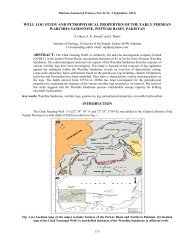GENETICALLY MODIFIED ORGANISMS (GMOs ... - Paas.com.pk
GENETICALLY MODIFIED ORGANISMS (GMOs ... - Paas.com.pk
GENETICALLY MODIFIED ORGANISMS (GMOs ... - Paas.com.pk
You also want an ePaper? Increase the reach of your titles
YUMPU automatically turns print PDFs into web optimized ePapers that Google loves.
Pakistan Journal of Science (Vol. 64 No. 2 June, 2012)<br />
major seed, water, land and other primary agricultural<br />
resources – converting them to exported cash rather than<br />
local survival crops. This is likely to further unravel the<br />
self-sufficiency of those cultures - and as with the past<br />
failures of the "green revolution." (Nathan, 2009).<br />
Conclusion: The reason that <strong>GMOs</strong> have recently<br />
attracted the attention of agricultural, medical and food<br />
scientists and governments of many countries in the<br />
world is due to an increasing concern that the<br />
re<strong>com</strong>binant gene(s) inserted into an organism may result<br />
in unforeseen effects. Alongwith the potential benefits<br />
GMO’s may have some hazards too. Therefore the first<br />
and most important reason for regulating <strong>GMOs</strong> use is to<br />
ensure human safety and the second reason is to protect<br />
the environment. Whether regulation is established to<br />
‘protect’ or ‘safeguard’ human health or the environment,<br />
the government’s goal is to minimize or eliminate any<br />
real or potential hazards. The economic results so far<br />
suggest that farmers in developing countries can benefit<br />
from transgenic crops, but a certain level of national<br />
research and regulatory capacity are prerequisites, along<br />
with effective IPR management and input supply<br />
systems, especially for seeds Therefore, to reap from the<br />
benefits of the new technology with maximum care to the<br />
environment, there should be strong detection and<br />
quantification tools in place. It is therefore dire need of<br />
the hour to create awareness about benefit/hazard<br />
analysis of <strong>GMOs</strong> at all levels. The following strategies<br />
would help enable developing countries to satisfy<br />
production, consumption, international trade, and riskmanagement<br />
objectives simultaneously and also <strong>com</strong>ply<br />
with their international obligations.<br />
A <strong>com</strong>prehensive but practical biosafety<br />
regulatory process for GM crop production and imported<br />
GM food for consumption based on international<br />
standards must be adopted.<br />
In cases of <strong>com</strong>modities with proven risk of<br />
potential export loss, adoption of strategies that help<br />
segregate GM and non-GM food for sensitive exportable<br />
markets is re<strong>com</strong>mended.<br />
Adopting these proposed policies would<br />
mitigate the observed negative effects of trade-related<br />
regulations, allowing developing countries to fully<br />
benefit from the use of safe transgenic crops and their<br />
products.<br />
Establishment of R&D/analytical facilities to<br />
identify transgenes in food items and to develop simple<br />
rugged and robust method for detection of <strong>GMOs</strong> through<br />
molecular biology techniques.<br />
REFERENCES<br />
Abdullah, T., S. Radu, Z. Hassan and J. K. Hashim.<br />
Detection of genetically modified soy in<br />
processed foods sold <strong>com</strong>mercially in Malaysia<br />
by PCR-based method. Food Chem., 98:575–<br />
579 (2006).<br />
Adugna, A. and T. Mesfin. Detection and quantification<br />
of genetically engineered crops. J. SAT Agri.<br />
Res., 6:1-9 (2008).<br />
Agodi, A. Detection of genetically modified DNA<br />
sequences in milk from the Italian market. Int J<br />
Hyg Environ Health 209: 81–88 (2006).<br />
Baker, J. and C. Preston. Predicting the spread of<br />
herbicide resistance in Australian canola fields.<br />
Trans. Res., 12:731–737 (2003).<br />
Bao-Rong, L. and S. A. Allison. Gene flow from<br />
genetically modified rice and its<br />
environmentalconsequences.(2005). (www.<br />
biosci.ohiostate. edu/~asnowlab/LuandSnow)<br />
Bates, S.L., J. Zhao, R.T. Roush and A.M. Shelton. Insect<br />
resistance management in GM crops: past<br />
present and future. Nat. Biotech., 23(1): 57-<br />
62(2005).<br />
Benbrook, C. Genetically Engineered Crops and Pesticide<br />
Use in the United States: The First Nine Years.<br />
Bio.Tech. Info.Net, Technical Paper Number 7,<br />
(2004).<br />
Benbrook, C. Impacts of Genetically Engineered Crops<br />
on Pesticide Use: The First Thirteen Years. The<br />
Organic Center, (2009). http://www.organiccenter.org/science.pest.phpaction=view&report<br />
_id=159<br />
Borlaug, N.E. The green revolution revisited and the road<br />
ahead. Special 30th Anniversary Lecture. Oslo,<br />
Norway: The Norwegian Nobel Institute.<br />
(2000).<br />
British Medical Association. Biotechnology, Weapons<br />
and Humanity.Pp176.1 st ed. CRC Press, London<br />
(1999).<br />
Brookes, G. and P. Barfoot. GM Crops: The First Ten<br />
Years - Global Socio-Economic and<br />
Environmental Impacts.Pp.2-116. Brief No. 36.<br />
ISAAA, Ithaca, NewYork (2006).<br />
Brown, M.E. and C.C. Funk. Climate. Food security<br />
under climate change. Sci., 319 (5863): 580–1<br />
(2008)<br />
Bucchini, L. and L. Goldman. Starlink corn: a risk<br />
analysis. Environ. Health Persp.110: 5-13(2002).<br />
Codex Alimentarius. Foods derived from biotechnology,<br />
Joint FAO/WHO Food Standards Program.<br />
(2004)http://www.fao.org/docrep/007/y5819e<br />
/y5819e00.htm<br />
Conner, A.J., T.R. Glare, and J.P. Nap. The release of<br />
genetically modified crops in the environment,<br />
Part ll Overview of ecological risk assessment.<br />
The Plant Journal, , 33(1), 19-46 (2003).<br />
David, E. H. <strong>GMOs</strong> and agriculture: Facts, fears, and<br />
foods. Proceedings of the 24th Technical Turkey<br />
Conference p.39 (2001).<br />
89















